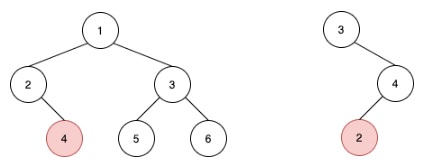Breadth First Search Algorithm to Find Nearest Right Node in Bin
- 时间:2020-10-07 14:14:07
- 分类:网络文摘
- 阅读:132 次
Given the root of a binary tree and a node u in the tree, return the nearest node on the same level that is to the right of u, or return null if u is the rightmost node in its level.
Example 1:
Input: root = [1,2,3,null,4,5,6], u = 4
Output: 5
Explanation: The nearest node on the same level to the right of node 4 is node 5.Example 2:
Input: root = [3,null,4,2], u = 2
Output: null
Explanation: There are no nodes to the right of 2.Example 3:
Input: root = [1], u = 1
Output: nullExample 4:
Input: root = [3,4,2,null,null,null,1], u = 4
Output: 2Constraints:
The number of nodes in the tree is in the range [1, 105].
1 <= Node.val <= 105
All values in the tree are distinct.
u is a node in the binary tree rooted at root.
Find Nearest Right Node in Binary Tree using BFS Algorithm
We know that the Breadth First Search Algorithm (BFS) traverses the tree/graph level-by-level. Thus, we know when we meet a given node – its next right neigbour on the same level. This is do-able by expanding the children nodes all at once.
At each iteration – we record the number of the nodes in the queue – which is the number of the total nodes that are all in the same level.
1 2 3 4 5 6 7 8 9 10 11 12 13 14 15 16 17 18 19 20 21 22 23 24 25 26 27 28 29 30 31 32 33 34 35 | /** * Definition for a binary tree node. * struct TreeNode { * int val; * TreeNode *left; * TreeNode *right; * TreeNode() : val(0), left(nullptr), right(nullptr) {} * TreeNode(int x) : val(x), left(nullptr), right(nullptr) {} * TreeNode(int x, TreeNode *left, TreeNode *right) : val(x), left(left), right(right) {} * }; */ class Solution { public: TreeNode* findNeartestRightNode(TreeNode* root, TreeNode* u) { if (!root) return NULL; queue<TreeNode*> Q; Q.push(root); while (!Q.empty()) { auto sz = Q.size(); for (int i = 0; i < sz; ++ i) { auto p = Q.front(); Q.pop(); if (p == u) { // given node if (i == sz - 1) { // if we don't have right node(s) return NULL; } return Q.front(); } if (p->left) Q.push(p->left); if (p->right) Q.push(p->right); } } return NULL; } }; |
/**
* Definition for a binary tree node.
* struct TreeNode {
* int val;
* TreeNode *left;
* TreeNode *right;
* TreeNode() : val(0), left(nullptr), right(nullptr) {}
* TreeNode(int x) : val(x), left(nullptr), right(nullptr) {}
* TreeNode(int x, TreeNode *left, TreeNode *right) : val(x), left(left), right(right) {}
* };
*/
class Solution {
public:
TreeNode* findNeartestRightNode(TreeNode* root, TreeNode* u) {
if (!root) return NULL;
queue<TreeNode*> Q;
Q.push(root);
while (!Q.empty()) {
auto sz = Q.size();
for (int i = 0; i < sz; ++ i) {
auto p = Q.front();
Q.pop();
if (p == u) { // given node
if (i == sz - 1) { // if we don't have right node(s)
return NULL;
}
return Q.front();
}
if (p->left) Q.push(p->left);
if (p->right) Q.push(p->right);
}
}
return NULL;
}
};The runtime complexity is O(N) where N is the number of the nodes in the binary tree and the space requirement is also O(N) as we are using a queue to perform the Breadth First Search Algorithm.
–EOF (The Ultimate Computing & Technology Blog) —
推荐阅读:邹忌讽齐王纳谏原文及翻译 范雎说秦王原文及翻译 三个博客写作技巧坚持了10年 养活了他一家子! 百度搜索正式升级冰桶算法5.0 现在的建站公司都有哪些套路?真会吹! 百度反推算法,又一次站长和百度之间的较量 百度搜索低调改版搜索界面 STUSEO研究社Nico:seo的核心思想和seo影响因素综合分析 委托建站公司搭建的网站,会涉嫌源码侵权? 99%的网站死于太丑!!!
- 评论列表
-
- 添加评论
